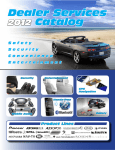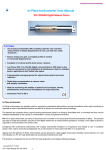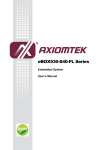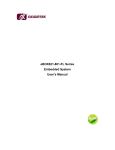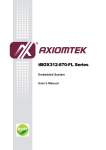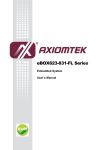Download eBOX620-831-FL-CAN User`s Manual VA1-20111115
Transcript
eBOX620-831-FL-CAN Series Embedded System User’s Manual Disclaimers This manual has been carefully checked and believed to contain accurate information. AXIOMTEK Co., Ltd. assumes no responsibility for any infringements of patents or any third party’s rights, and any liability arising from such use. AXIOMTEK does not warrant or assume any legal liability or responsibility for the accuracy, completeness or usefulness of any information in this document. AXIOMTEK does not make any commitment to update the information in this manual. AXIOMTEK reserves the right to change or revise this document and/or product at any time without notice. No part of this document may be reproduced, stored in a retrieval system, or transmitted, in any form or by any means, electronic, mechanical, photocopying, recording, or otherwise, without the prior written permission of AXIOMTEK Co., Ltd. Copyright 2011 AXIOMTEK Co., Ltd. All Rights Reserved Nov 2011, Version A1 Printed in Taiwan ii Safety Precautions Before getting started, please read the following important safety precautions. 1. The eBOX620-831-FL-CAN does not come equipped with an operating system. An operating system must be loaded first before installing any software into the computer. 2. Be sure to ground yourself to prevent static charge when installing the internal components. Use a grounding wrist strap and place all electronic components in any staticshielded devices. Most electronic components are sensitive to static electrical charge. 3. Disconnect the power cord from the eBOX620-831-FL-CAN before making any installation. Be sure both the system and the external devices are turned OFF. Sudden surge of power could ruin sensitive components. Make sure the eBOX620831-FL-CAN is properly grounded. 4. Make sure the voltage of the power source is correct before connecting the equipment to the power outlet. 5. Turn OFF the system power before cleaning. Clean the system using a cloth only. Do not spray any liquid cleaner directly onto the screen. 6. Do not leave this equipment in an uncontrolled environment where the storage temperature is below -20℃ or above 60℃. It may damage the equipment. 7. Do not open the system’s back cover. If opening the cover for maintenance is a must, only a trained technician is allowed to do so. Integrated circuits on computer boards are sensitive to static electricity. To avoid damaging chips from electrostatic discharge, observe the following precautions: iii Before handling a board or integrated circuit, touch an unpainted portion of the system unit chassis for a few seconds. This will help to discharge any static electricity on your body. When handling boards and components, wear a wristgrounding strap, available from most electronic component stores. iv Classification 1. Degree of production against electric shock : not classified 2. Degree of protection against the ingress of water : IP40 3. Equipment not suitable for use in the presence of a flammable anesthetic mixture with air or with oxygen or nitrous oxide. 4. Mode of operation : Continuous v General Cleaning Tips You may need the following precautions before you begin to clean the computer. When you clean any single part or component for the computer, please read and understand the details below fully. When you need to clean the device, please rub it with a piece of dry cloth. 1. Be cautious of the tiny removable components when you use a vacuum cleaner to absorb the dirt on the floor. 2. Turn the system off before you start to clean up the component or computer. 3. Never drop the components inside the computer or get circuit board damp or wet. 4. Be cautious of all kinds of cleaning solvents or chemicals when you use it for the sake of cleaning. Some individuals may be allergic to the ingredients. 5. Try not to put any food, drink or cigarette around the computer. Cleaning Tools: Although many companies have created products to help improve the process of cleaning your computer and peripherals users can also use household items to clean their computers and peripherals. Below is a listing of items you may need or want to use while cleaning your computer or computer peripherals. Keep in mind that some components in your computer may only be able to be cleaned using a product designed for cleaning that component, if this is the case it will be mentioned in the cleaning. vi Cloth: A piece of cloth is the best tool to use when rubbing up a component. Although paper towels or tissues can be used on most hardware as well, we still recommend you to rub it with a piece of cloth. Water or rubbing alcohol: You may moisten a piece of cloth a bit with some water or rubbing alcohol and rub it on the computer. Unknown solvents may be harmful to the plastics parts. Vacuum cleaner: Absorb the dust, dirt, hair, cigarette particles, and other particles out of a computer can be one of the best methods of cleaning a computer. Over time these items can restrict the airflow in a computer and cause circuitry to corrode. Cotton swabs: Cotton swaps moistened with rubbing alcohol or water are excellent tools for wiping hard to reach areas in your keyboard, mouse, and other locations. Foam swabs: Whenever possible it is better to use lint free swabs such as foam swabs. Note We strongly recommended that you should shut down the system before you start to clean any single components. Please follow the steps below: 1. Close all application programs 2. Close operating software 3. Turn off power switch 4. Remove all device 5. Pull out power cable vii Scrap Computer Recycling If the computer equipments need the maintenance or are beyond repair, we strongly recommended that you should inform your AXIOMTEK distributor as soon as possible for the suitable solution. For the computers that are no longer useful or no longer working well, please contact your AXIOMTEK distributor for recycling and we will make the proper arrangement. Trademarks Acknowledgments AXIOMTEK is a trademark of AXIOMTEK Co., Ltd. IBM, PC/AT, PS/2, VGA are trademarks of International Business Machines Corporation. Intel ® and Pentium ® are registered trademarks of Intel Corporation. Windows ® Vista, Windows ® XPE, Windows ® XP, Windows WinCE embedded and Linux, MS-DOS, Microsoft C and QuickBASIC are trademarks of Microsoft Corporation. Other brand names and trademarks are the properties and registered brands of their respective owners. viii ® Table of Contents Disclaimers ................................................................................................................... ii Safety Precautions .................................................................................................... iii Classification ................................................................................................................ v General Cleaning Tips ............................................................................................. vi Scrap Computer Recycling ................................................................................. viii CHAPTER 1 .......................................................................................................................... 1 INTRODUCTION ................................................................................................................ 1 1.1 General Description .......................................................................... 2 1.2 System Specifications ...................................................................... 4 1.2.1 CPU ........................................................................................................... 4 1.2.2 I/O System ............................................................................................. 4 1.2.3 System Specification ......................................................................... 5 1.2.4 Driver CD Content .............................................................................. 6 1.3 Dimensions........................................................................................... 7 1.4 I/O Outlets ............................................................................................ 8 1.5 Packing List.........................................................................................10 CHAPTER 2 ........................................................................................................................12 HARDWARE INSTALLATION ......................................................................................12 2.1 Installing the Memory Module ..................................................13 2.2 Installing the SATA HDD ...............................................................17 2.3 Installing the CompactFlash ........................................................22 2.4 Installing the Wall Mount .............................................................24 2.4 Installing the VESA Mount (optional) ......................................27 2.5 Installing the Din-Rail Mount (optional) ................................31 CHAPTER 3 ........................................................................................................................35 Jumper Setting & Connector .....................................................................................35 3.1 SBC layout ...........................................................................................35 ix 3.2 Jumper Setting Summary .............................................................37 3.2.1 Audio Output Jumper (JP2) .........................................38 3.2.2 CompactFlash™ Voltage Jumper (JP4)...................38 3.2.3 CMOS Clear Jumper (JP5).............................................39 3.3 Connectors .........................................................................................40 3.3.1 DC-in Jack Power Connector ......................................41 3.3.2 Serial Port Connector .....................................................41 3.3.3 VGA Connector.................................................................42 3.3.4 LAN Connector (LAN1, LAN2) ....................................43 3.3.5 USB Connector .................................................................43 3.3.6 ATX Power On/OFF Button ..........................................44 3.3.7 Audio Connector .............................................................44 3.3.8 Keyboard and PS/2 Mouse Connector ...................44 3.3.9 CANBUS Connector ........................................................45 3.3.10 SATA Connector ...............................................................45 3.3.11 SATA Power Connector.................................................46 3.3.12 CompactFlash™ Socket ................................................47 3.3.13 DDR2 SODIMM Socket .................................................48 CHAPTER 4 ........................................................................................................................49 AMI BIOS SETUP UTILITY .............................................................................................49 4.1 Starting ................................................................................................49 4.2 Navigation Keys................................................................................50 4.3 Main Menu .........................................................................................51 4.4 Advanced Menu ...............................................................................52 4.5 PCI PnP Menu ....................................................................................68 4.6 Boot Menu ..........................................................................................70 4.7 Security Menu ...................................................................................74 4.8 Chipset Menu ....................................................................................76 4.9 Exit Menu ............................................................................................80 APPENDIX A ......................................................................................................................82 x WATCHDOG TIMER .......................................................................................................82 What is Watchdog Timer ..............................................................82 Watchdog Timer Setting ..............................................................82 Timeout Value Range.....................................................................82 How to Use the Watchdog Timer .............................................83 Program Sample ..............................................................................84 APPENDIX B ......................................................................................................................85 CANBUS Introduction ...................................................................................................85 CANBUS Module Layout...............................................................85 Block Diagram ...................................................................................86 Pin Define ............................................................................................86 Connection for CAN transmission ............................................86 xi MEMO xii eBOX620-831-FL-CAN Series User’s Manual CHAPTER 1 INTRODUCTION This chapter contains general information and detailed specifications of the eBOX620-831-FL-CAN. The Chapter 1 includes the following sections: General Description System Specification Dimensions I/O Outlets Package List Introduction 1 eBOX620-831-FL-CAN Series User’s Manual 1.1 General Description The eBOX620-831-FL-CAN is an embedded system that supports ® onboard Intel ATOM™ N270 (1.6 GHz) processors to provide Windows ® Vista, Windows ® XPE, Windows ® XP, Windows ® WinCE embedded and Linux, suitable for the most endurable operation. It features fanless design with full feature I/O, one 200pin DDR2 SODIMM maximum up to 2GB, and enhanced system dependability by built-in Watchdog Timer. Features 1. Support Intel® Atom™ Processor N270 (512K Cache, 1.60 GHz, 533 MHz FSB) ® 2. Intel 945GSE + ICH7M chipset 3. Ultra slim and compact design 4. Supports 2 ports USB 2.0 and 3 COM ports 5. Supports dual 10/100/1000Mbps Ethernet port 6. Support 1 CANBUS 7. One 2.5” SATA HDD drive bay 8. One front access CompactFlash™ 9. Watchdog timer 10. Wall mount (optional) 11. VESA/Din-rail mount (optional) 2 Introduction eBOX620-831-FL-CAN Series User’s Manual Reliable and Stable Design The eBOX620-831-FL-CAN adopts the advanced cooling system and supporting the CompactFlash™ , which makes it especially suitable for vibration environments, best for industrial automation, digital signage and gaming application. Embedded O.S. Supported The eBOX620-831-FL-CAN not only supports Windows but also supports embedded OS, such as Windows Windows ® ® ® XP, Vista, XP embedded, WinCE and Linux. For storage device, the eBOX620-831-FL-CAN supports one 2.5" SATA HDD drive bay, and one CompactFlash™ type II slot. Introduction 3 eBOX620-831-FL-CAN Series User’s Manual 1.2 System Specifications 1.2.1 CPU CPU Onboard Intel® Atom™ Processor N270 (512K Cache, 1.60 GHz, 533 MHz FSB) BIOS AMI 8Mbit SPI Flash, DMI, Plug and Play System Memory One 200-pin DDR2 400/533MHz SODIMM max. up to 2 GB 1.2.2 I/O System System I/O Outlet Three 9-pin D-Sub male connectors, COM1~3 for RS-232 One 9-pin D-sub female connector for CANBUS One 15-pin D-Sub female connector for VGA One Audio connector (Line-IN, Line-OUT) One PS/2 connector for Keyboard and M/S through Y-Type cable Two RJ-45 connector for 10/100/1000Base-T Ethernet Two USB 2.0 connectors One 12V DC-IN Jack power input connector 4 Introduction eBOX620-831-FL-CAN Series User’s Manual 1.2.3 System Specification Watchdog Timer Reset supported; 255 levels, 1~255 sec. Power Supply External 12V@5A, 60W AC/DC power adapter Operation Temperature -10℃ ~ 50℃ (32 ºF ~ 122ºF), with W .T. HDD Storage Temperature -20℃ ~ 80℃ (-4 ºF ~ 176ºF) Humidity 10% ~ 90% (non-condensation) Vibration Endurance 3Grm w/ CF(5-500Hz, X, Y, Z directions) Weight 1.8 kg (1.1 lb) without package 2.6 kg (17.64 lb) with package Dimensions 200mm(7.87”) (W) x 120mm(4.72”) (D) x 56mm(2.2”) (H) Introduction 5 eBOX620-831-FL-CAN Series User’s Manual 1.2.4 Driver CD Content Driver Audio Driver Chipset Driver Ethernet Driver Graphic Driver Manual User Manual Quick Manual Utility CANBUS Command User Manual CANBUS Programmer’s Guide CANBUS Library AXCAN CANBUS diagnostic tool NOTE All specifications and images are subject to change without notice. 6 Introduction eBOX620-831-FL-CAN Series User’s Manual 1.3 Dimensions The following diagrams show you dimensions and outlines of the eBOX620-831-FL-CAN. Introduction 7 eBOX620-831-FL-CAN Series User’s Manual 1.4 I/O Outlets The following figures show you I/O outlets on front view of the eBOX620-831-FL-CAN. Front View Front View drawing POWER-ON 12V DC-IN AUDIO Power & HDD POWER CONNECTORS Active INPUT Indicators CONNECTOR 8 Introduction eBOX620-831-FL-CAN Series User’s Manual Rear View Rear View drawing 2 x USB 2.0 RJ-45 CONNECTORS PS/2 CONNECTORS FOR Ethernet CONNECTORS VGA CONNECTOR Front Access CF slot COM1/2/3 CANBUS cover CONNECTORS CONNECTOR Introduction 9 eBOX620-831-FL-CAN Series User’s Manual 1.5 Packing List The package bundled with your eBOX620-831-FL-CAN should contain the following items: eBOX620-831-FL-CAN System Unit x 1 eBOX620-831-FL-CAN Quick Manual x 1 CD x 1 (For Driver and User’s Manual) Keyboard/Mouse Y-cable Screws pack x1 Foot pad x4 60W AC/DC Power Adapter x1 CompactFlash card Handhold Mylar x2 US Power Cord x 1 Japan Power Cord x 1 (optional) Australian Power Cord x 1 (optional) Chinese Power Cord x 1 (optional) UK Power Cord x 1 (optional) Wall-mount Brackets (optional) VESA-mount Bracket (optional) Din-rail Bracket (optional) HDD (optional) CF (optional) DRAM (optional) If you cannot find this package or any items are missing, please contact AXIOMTEK distributors immediately. 10 Introduction eBOX620-831-FL-CAN Series User’s Manual MEMO Introduction 11 eBOX620-831-FL-CAN Series User’s Manual CHAPTER 2 HARDWARE INSTALLATION The eBOX620-831-FL-CAN is convenient for your various hardware configurations, such as Memory Module, HDD (Hard Disk Drive), and CompactFlash TM install the hardware. 12 card. The chapter 2 will show you how to eBOX620-831-FL-CAN Series User’s Manual 2.1 Installing the Memory Module Step 1 Turn off the system, and unplug the power cord. Step 2 Turn the system upside down to locate screws at the bottom, loosen screws. 13 eBOX620-831-FL-CAN Series User’s Manual Step 3 Remove the bottom cover. Step 4 Loosen screws of HDD bracket 14 eBOX620-831-FL-CAN Series User’s Manual Step 5 Remove the HDD bracket Step 6 Locate the memory module, insert the gold colored contact into the socket. 15 eBOX620-831-FL-CAN Series User’s Manual Step 7 Push the module down, until it is firmly seated by locking two latches on the sides. Step 8 Close the cover to the chassis, and fasten all screws. 16 eBOX620-831-FL-CAN Series User’s Manual 2.2 Installing the SATA HDD Step 1 Turn off the system, and unplug the power cord. Step 2 Turn the system upside down to locate screws at the bottom, loosen screws. 17 eBOX620-831-FL-CAN Series User’s Manual Step 3 Remove the bottom cover. Step 4 Loosen screws of HDD bracket 18 eBOX620-831-FL-CAN Series User’s Manual Step 5 Remove the HDD bracket Step 6 Assembly the HDD bracket together with the SATA HDD 19 eBOX620-831-FL-CAN Series User’s Manual Step 7 Connect SATA cable and power cable to SATA HDD. 20 eBOX620-831-FL-CAN Series User’s Manual Step 8 Close the HDD bracket to the chassis, and fasten all screws. Step 9 Close the bottom cover to the chassis, and fasten all screws. 21 eBOX620-831-FL-CAN Series User’s Manual 2.3 Installing the CompactFlash Step 1 Turn off the system, and unplug the AC/DC power cord. Step 2 Turn the system rotate to CF cover side and locate screws at the front and bottom side. Step 3 Loosen screws to remove the CF cover. 22 eBOX620-831-FL-CAN Series User’s Manual Step 3 Stick the Mylar onto the Compact Flash card CF card connector Mylar fin for hand hold Step 4 Slide CF card into CF slot with caution. Step 5 Close the cover to the chassis, and fasten all screws. 23 eBOX620-831-FL-CAN Series User’s Manual 2.4 Installing the Wall Mount The eBOX620-831-FL-CAN provides Wall Mount that customers can install as below: Step 1 Prepare Wall Mount assembling components (screws and bracket) ready. 24 eBOX620-831-FL-CAN Series User’s Manual Step 2 Loose the screw of four footpads at the bottom of eBOX620-831-FL-CAN and remove footpad. 25 eBOX620-831-FL-CAN Series User’s Manual Step 3 Fix the wall mount to the correct location, and fasten all screws. 26 eBOX620-831-FL-CAN Series User’s Manual 2.4 Installing the VESA Mount (optional) The eBOX620-831-FL-CAN provides VESA Mount that customers can install as below: Step 1 Prepare VESA Mount assembling components (screws and VESA mount bracket) ready. 27 eBOX620-831-FL-CAN Series User’s Manual Step 2 Loose the screw of four footpads at the bottom of eBOX620-831-FL-CAN, and remove footpad. 28 eBOX620-831-FL-CAN Series User’s Manual Step 3 Decide correct mounting direction. eBOX620-831-FLCAN supports both 100x100mm and 75x75mm VESA mount. The 100x100mm type has special direction. 100x100mm 75x75mm 29 eBOX620-831-FL-CAN Series User’s Manual Step 4 Fix the VESA mount to the correct location, and fasten all screws. 30 eBOX620-831-FL-CAN Series User’s Manual 2.5 Installing the Din-Rail Mount (optional) The eBOX620-831-FL-CAN provides Din-Rail Mount that customers can install as below: Step 1 Prepare Din-Rail Mount assembling components (screws, Din-rail and VESA mount bracket) ready. 31 eBOX620-831-FL-CAN Series User’s Manual Step 2 Loose the screw of four footpads at the bottom of eBOX620-831-FL-CAN, and remove footpad. Step 3 Fix the VESA mount to the correct location, and fasten all screws. 32 eBOX620-831-FL-CAN Series User’s Manual Step 4 Fix the Din-rail mount bracket to the correct location, and fasten all screws. 33 eBOX620-831-FL-CAN Series User’s Manual MEMO 34 eBOX620-831-FL-CAN Series User’s Manual CHAPTER 3 Jumper Setting & Connector Proper jumper settings configure the eBOX620-831-FL-CAN to meet your application purpose. We are herewith listing a summary table of all jumpers and default settings for onboard devices, respectively. 3.1 SBC layout Component Side 35 eBOX620-831-FL-CAN Series User’s Manual Solder Side NOTE: We strongly recommended that you should not modify any unmentioned jumper setting without AXIOMTEK FAE’s instruction. Any modification without instruction might cause system to become damage. 36 eBOX620-831-FL-CAN Series User’s Manual 3.2 Jumper Setting Summary Proper jumper settings configure the eBOX620-831-FL-CAN to meet your application purpose. We are herewith listing a summary table of all jumpers and default settings for onboard devices, respectively. Jumper JP2 JP4 JP5 Default Setting Audio Speak Out/Line Out Selection Default: Line Out Compact Flash Voltage Selection Default: 3.3V Normal Operation/Clear CMOS setting Default: Normal Operation Jumper Setting Short 1-3, 2-4 Short 1-2 Short 1-2 37 eBOX620-831-FL-CAN Series User’s Manual 3.2.1 Audio Output Jumper (JP2) This jumper is to select the Audio output. Description Function Jumper Setting Line Out (Default) Audio Output Speaker Out 3.2.2 CompactFlash™ Voltage Jumper (JP4) The jumper is to select the voltage for CompactFlash™ interface. Description Function 3.3V (Default) Compact Flash Voltage Selection 5V 38 Jumper Setting eBOX620-831-FL-CAN Series User’s Manual 3.2.3 CMOS Clear Jumper (JP5) You may need to use this jumper is to clear the CMOS memory if incorrect settings in the Setup Utility. Description Function Jumper Setting Normal (Default) CMOS Clear Clear CMOS 39 eBOX620-831-FL-CAN Series User’s Manual 3.3 Connectors Connectors connect the board with other parts of the system. Loose or improper connection might cause problems. Make sure all connectors are properly and firmly connected. Here is a summary table shows you all connectors on the eBOX620-831-FL-CAN Series. External Connectors Section DC-in Jack Power Connector 3.3.1 Serial Port Connector 3.3.2 VGA Connector 3.3.3 LAN Connector 3.3.4 USB Connector 3.3.5 ATX Power Switch 3.3.6 Audio Connector 3.3.7 PS/2 Connector 3.3.8 CANBUS Connector 3.3.9 Internal Connectors Section SATA Connector 3.3.10 SATA Power Connector 3.3.11 CompactFlash™ Socket 3.3.12 DDR2 SO-DIMM 3.3.13 40 eBOX620-831-FL-CAN Series User’s Manual 3.3.1 DC-in Jack Power Connector Connect it to the power AC-DC 60W Adapter Pin Signal 1 +12V 2 GND 3.3.2 Serial Port Connector The system has three serial ports. COM1~COM3 are RS-232 ports. Pin Description 1 DCD, Data Carrier Detect 2 RXD, Receive Data 3 TXD, Transmit Data 4 DTR, Data Terminal Ready 5 GND, Ground 6 DSR, Data Set Ready 7 RTS, Request To Send 8 CTS, Clear To Send 9 RI, Ring Indicator Pin COM1 Description 1 DCD, Data Carrier Detect 2 RXD, Receive Data 3 TXD, Transmit Data 4 DTR, Data Terminal Ready 5 GND, Ground 6 DSR, Data Set Ready 7 RTS, Request To Send 8 CTS, Clear To Send 9 RI, Ring Indicator COM2 41 eBOX620-831-FL-CAN Series User’s Manual Pin Description 1 DCD, Data Carrier Detect 2 RXD, Receive Data 3 TXD, Transmit Data 4 DTR, Data Terminal Ready 5 GND, Ground 6 DSR, Data Set Ready 7 RTS, Request To Send 8 CTS, Clear To Send 9 RI, Ring Indicator COM3 3.3.3 VGA Connector The VGA connector is a slim type 15-pin D-Sub connector which is common for the CRT VGA display. The VGA interface configuration can be configured via the software utility. Pin Signal Pin Signal Pin Signal 1 Red 2 Green 3 Blue 4 N.C. 5 GND 6 DETECT 7 GND 8 GND 9 VCC 10 GND 11 N.C. 12 DDC DATA 13 Horizontal Sync 14 Vertical Sync 15 DDC CLK 42 eBOX620-831-FL-CAN Series User’s Manual 3.3.4 LAN Connector (LAN1, LAN2) The RJ-45 connector is for Ethernet. To connect the board to a 1000/100/10 Base-T hub, just plug one end of the cable into connector and connect the other end (phone jack) to a 1000/100/10-Base-T hub Pin Signal Pin Signal L1 MDI0+ L5 MDI2- L2 MDI0- L6 MDI1- L3 MDI1+ L7 MDI3+ L4 MDI2+ L8 MDI3- A B A B Active LED (Yellow) 100 LAN LED (Green)/ 1000 LAN LED (Orange) 3.3.5 USB Connector These ports can be routed to UHCI controller #1 or EHCI controller #1. Pin 1 Signal USB Port 0 USB VCC (+5V level) Pin 5 Signal USB Port 1 USB VCC (+5V level) 2 USB #0_D- 6 USB #1_D- 3 USB #0_D+ 7 USB #1_D+ 4 Ground (GND) 8 Ground (GND) 43 eBOX620-831-FL-CAN Series User’s Manual 3.3.6 ATX Power On/OFF Button The ATX power button is on the I/O side. It can allow users to control eBOX620-801-FL power on/off. Pin Signal 1 GND 2 PSIN 3.3.7 Audio Connector These two audio jacks ideal are for Audio Mic-In and Audio Lineout. Pin Signal 1 Microphone In 2 Line Out 3.3.8 Keyboard and PS/2 Mouse Connector The board supports a keyboard and Mouse interface. Connector is a DIN connector for PS/2 keyboard Connection VIA “Y” Cable. Pin 44 Signal 1 Keyboard Data 2 Mouse Data 3 GND 4 VCC 5 Keyboard Clock 6 Mouse Clock eBOX620-831-FL-CAN Series User’s Manual 3.3.9 CANBUS Connector The system supports a CANBUS interface, the connector is a 9-pin D-sub connector. It supports CAN 2.0A and 2.0B standard. Pin Description 1 NC 2 CAN_L 3 CAN_GND 4 NC 5 NC 6 CAN_GND 7 CAN_H 8 NC 9 NC CANBUS 3.3.10 SATA Connector The SATA connector is for high-speed SATA interface ports and they can be connected to hard disk devices. Pin Signal 1 GND 2 SATA_TX+ 3 SATA_TX- 4 GND 5 SATA_RX- 6 SATA_RX+ 7 GND 45 eBOX620-831-FL-CAN Series User’s Manual 3.3.11 SATA Power Connector Pin Signal 1 N/A 2 N/A 3 N/A 4 COM 5 COM 6 COM 7 +5 VDC 8 +5 VDC 9 +5 VDC 10 COM 11 COM 12 COM 13 +12 VDC 14 +12 VDC 15 +12 VDC 46 1 15 eBOX620-831-FL-CAN Series User’s Manual 3.3.12 CompactFlash™ Socket The system is equipped with a CompactFlash TM type-II socket with DMA mode to support an IDE interface CompactFlash TM disk. The socket is designed to avoid incorrect installation of the CompactFlash TM disk card. When installing or removing the CompactFlash TM disk card, please make sure the system power is off. The CompactFlash TM disk card is defaulted as the C: or D: disk drive in your PC system. Pin13 and Pin 38 power voltage can be referred to JP3 Jumper Setting (See Section 3.2.1). Pin Signal Pin Signal 1 GND 26 CD1- 2 Data 3 27 Data 11 3 Data 4 28 Data 12 4 Data 5 29 Data 13 5 Data 6 30 Data 14 6 Data 7 31 Data 15 7 CS0# 32 CS1# 8 Address 10 33 VS1# 9 ATASEL 34 IORD# 10 Address 9 35 IOWR# 11 Address 8 36 WE# 12 Address 7 37 INTR 13 VCC 38 VCC 14 Address 6 39 CSEL# 15 Address 5 40 VS2# 16 Address 4 41 RESET# 17 Address 3 42 IORDY# 47 eBOX620-831-FL-CAN Series User’s Manual 18 Address 2 43 DMAREQ 19 Address 1 44 DMAACK- 20 Address 0 45 DASP# 21 Data 0 46 PDIAG# 22 Data 1 47 Data 8 23 Data 2 48 Data 9 24 IOCS16# 49 Data 10 25 CD2# 50 GND 3.3.13 DDR2 SODIMM Socket eBOX620-831-FL-CAN supports standard DDR2 200-pin 400/533 MHz SO-DIMM pin define. 48 eBOX620-831-FL-CAN Series User’s Manual CHAPTER 4 AMI BIOS SETUP UTILITY This chapter provides users with detailed description how to set up basic system configuration through the AMIBIOS8 BIOS setup utility. 4.1 Starting To enter the setup screens, follow the steps below: 1. Turn on the computer and press the <Del> key immediately. 2. After you press the <Delete> key, the main BIOS setup menu displays. You can access the other setup screens from the main BIOS setup menu, such as the Chipset and Power menus. 49 eBOX620-831-FL-CAN Series User’s Manual 4.2 Navigation Keys The BIOS setup/utility uses a key-based navigation system called hot keys. Most of the BIOS setup utility hot keys can be used at any time during the setup navigation process. These keys include <F1>, <F10>, <Enter>, <ESC>, <Arrow> keys, and so on. Note Some of navigation keys differ from one screen to another. Left/Right Up/Down +− − Plus/Minus Tab F1 The Left and Right <Arrow> keys allow you to select a setup screen. The Up and Down <Arrow> keys allow you to select a setup screen or sub-screen. The Plus and Minus <Arrow> keys allow you to change the field value of a particular setup item. The <Tab> key allows you to select setup fields. The <F1> key allows you to display the General Help screen. The <F10> key allows you to save any changes you F10 have made and exit Setup. Press the <F10> key to save your changes. The <Esc> key allows you to discard any changes you Esc have made and exit the Setup. Press the <Esc> key to exit the setup without saving your changes. The <Enter> key allows you to display or change the Enter setup option listed for a particular setup item. The <Enter> key can also allow you to display the setup sub- screens. 50 eBOX620-831-FL-CAN Series User’s Manual 4.3 Main Menu When you first enter the Setup Utility, you will enter the Main setup screen. You can always return to the Main setup screen by selecting the Main tab. There are two Main Setup options. They are described in this section. The Main BIOS Setup screen is shown below. System Time/Date Use this option to change the system time and date. Highlight System Time or System Date using the <Arrow> keys. Enter new values through the keyboard. Press the <Tab> key or the <Arrow> keys to move between fields. The date must be entered in MM/DD/YY format. The time is entered in HH:MM:SS format. 51 eBOX620-831-FL-CAN Series User’s Manual 4.4 Advanced Menu The Advanced menu allows users to set configuration of the CPU and other system devices. You can select any of the items in the left frame of the screen to go to the sub menus: CPU Configuration IDE Configuration Super IO Configuration Hardware Health Configuration ACPI Configuration APM Configuration MPS Configuration PCI Express Configuration USB Configuration For items marked with “”, please press <Enter> for more options. 52 eBOX620-831-FL-CAN Series User’s Manual Configure advanced CPU settings This screen shows the CPU Configuration, and you can change the value of the selected option. Max CPUID Value Limit You can enable this item to let legacy operating systems boot even without support for CPUs with extended CPU ID functions. Execute-Disable Bit Capability This item helps you enable or disable the No-Execution Page Protection Technology. Hyper Threading Technology Use this item to enable or disable Hyper-Threading Technology, which makes a single physical processor perform multi-tasking function as two logical ones. Intel (R) SpeedStep (tm) tech This item helps you enable or disable the Intel SpeedStep Technology. 53 eBOX620-831-FL-CAN Series User’s Manual Intel (R) C-STATE tech Use this item to enable or disable the C-State technology. Enhanced C-States This item allows you to enable or disable any available enhanced C-states ( C1E, C2E, C3E, C4E and Hard C4E). IDE Configuration You can use this screen to select options for the IDE Configuration, and change the value of the selected option. A description of the selected item appears on the right side of the screen. For items marked with “”, please press <Enter> for more options. ATA/IDE Configuration Use this item to specify the integrated IDE controller. There are three options for your selection: Disabled, Compatible and Enhanced. 54 eBOX620-831-FL-CAN Series User’s Manual Legacy IDE Channels When the ATA/IDE Configuration is set to Compatible, this item will be displayed. Primary/Secondary IDE Master Select one of the hard disk drives to configure IDE devices installed in the system by pressing <Enter> for more options. Super IO Configuration You can use this screen to select options for the Super IO Configuration, and change the value of the selected option. A description of the selected item appears on the right side of the screen. Serial Port1 Address This item specifies the base I/O port address and Interrupt Request address of serial port 1. The Optimal setting is 3F8/IRQ4. 55 eBOX620-831-FL-CAN Series User’s Manual Serial Port1 IRQ This item specifies the IRQ used by the serial port 1. Serial Port2 Address This item specifies the base I/O port address and Interrupt Request address of serial port 2. The Optimal setting is 2F8/IRQ3. Serial Port2 IRQ This item specifies the IRQ used by the serial port 2. Serial Port3 Address This item specifies the base I/O port address and Interrupt Request address of serial port 3. The Optimal setting is 3E8/IRQ11. Serial Port3 IRQ This item specifies the IRQ used by the serial port 3. Serial Port4 Address This item specifies the base I/O port address and Interrupt Request address of serial port 4. The Optimal setting is 2E8/IRQ10. Serial Port4 IRQ This item specifies the IRQ used by the serial port 4. 56 eBOX620-831-FL-CAN Series User’s Manual Hardware Health Configuration This screen shows the Hardware Health Configuration, and a description of the selected item appears on the right side of the screen. System Temperature/CPU Temperature These items display the temperature of CPU and System, Vcore, etc. 57 eBOX620-831-FL-CAN Series User’s Manual ACPI Settings You can use this screen to select options for the ACPI Settings, and change the value of the selected option. A description of the selected item appears on the right side of the screen. 58 eBOX620-831-FL-CAN Series User’s Manual General ACPI Configuration Scroll to this item and press <Enter> to view the General ACPI Configuration sub menu, which contains General ACPI (Advanced Configuration and Power Management Interface) options for your configuration. 59 eBOX620-831-FL-CAN Series User’s Manual Advanced ACPI Configuration Scroll to this item and press <Enter> to view the Advanced ACPI Configuration sub menu, which contains Advanced ACPI (Advanced Configuration and Power Management Interface) options for your configuration. 60 eBOX620-831-FL-CAN Series User’s Manual South Bridge ACPI Configuration Scroll to this item and press <Enter> to view the Chipset ACPI Configuration sub menu, which contains Chipset ACPI (Advanced Configuration and Power Management Interface) options for your configuration. 61 eBOX620-831-FL-CAN Series User’s Manual APM Configuration You can use this screen to select options for the APM Configuration, and change the value of the selected option. A description of the selected item appears on the right side of the screen. Power Management/APM Set this item to allow Power Management/APM support. The default setting is Enabled. Disabled Set this item to prevent the chipset power management and APM (Advanced Power Management) features. Set this item to allow the chipset power management Enabled and APM (Advanced Power Management) features. This is the default setting. Video Power Down Mode This option specifies the Power State that the video subsystem enters when the BIOS places it in a power saving state after the specified period of display inactivity has expired. The default setting is Suspend. 62 eBOX620-831-FL-CAN Series User’s Manual This setting prevents the BIOS from initiating any power Disabled saving modes concerned with the video display or monitor. This option places the monitor into suspend mode after the specified period of display inactivity has expired. This means the monitor is not off. The screen will appear Suspend blacked out. The standards do not cite specific power ratings because they vary from monitor to monitor, but this setting use less power than Standby mode. This is the default setting. Hard Disk Drive Power Down Mode This option specifies the power conserving state that the hard disk drive enters after the specified period of hard drive inactivity has expired. The default setting is Suspend. Disabled Suspend This setting prevents hard disk drive power down mode. This option cuts the power to the hard disk drives during a system suspend. This is the default setting. Suspend Time Out (Minute) This option specifies the length of time the system waits before it enters suspend mode. The default setting is Disabled. Disabled 1 Min 4 Min 10 Min This setting prevents the system from entering suspend mode. This is the default setting. Set this item to allow the computer system to enter suspend mode after being inactive for 1 minute. Set this item to allow the computer system to enter suspend mode after being inactive for 4 minutes. Set this item to allow the computer system to enter suspend mode after being inactive for 10 minutes. Throttle Slow Clock Ratio Use this item to specify the speed of the system clock when 63 eBOX620-831-FL-CAN Series User’s Manual running the power saving states. Power Button Mode This option specifies how the externally mounted power button on the front of the computer chassis is used. The default setting is On/Off. On/Off Suspend Pushing the power button turns the computer on or off. This is the default setting. This is the default setting. Pushing the power button places the computer in Suspend mode or Full On power mode. *** Advanced Resume Event Controls *** Resume On Ring This item enables or disables the function of Resume On Ring that resumes the system through incoming calls. Resume On LAN This item enables or disables the function of Resume On LAN that resumes the system through the network. Resume On RTC Alarm You can set “Resume On RTC Alarm” item to enabled and key in Data/time to power on system. 64 eBOX620-831-FL-CAN Series User’s Manual MPS Configuration This screen shows the MPS (Multi Processor Specification) Configuration, and you can change its value. A description of the selected item appears on the right side of the screen. MPS Revision Use this item to select MPS (Multi Processor Specification) Revision 1.1 or 1.4. The default setting is 1.4. 65 eBOX620-831-FL-CAN Series User’s Manual PCI Express Configuration This screen shows the PCI Express Configuration, and you can change its value. A description of the selected item appears on the right side of the screen. Active State Power-Management Use this item to enable or disable the function of Active State Power-Management to provide you with lower power consumption. The default setting is Disabled. 66 eBOX620-831-FL-CAN Series User’s Manual USB Configuration You can use this screen to select options for the USB Configuration, and change the value of the selected option. A description of the selected item appears on the right side of the screen. Legacy USB Support Use this item to enable or disable support for USB device on legacy operating system. The default setting is Enabled. USB 2.0 Controller Mode Use this item to configure the USB 2.0 controller. The default setting is HiSpeed. BIOS EHCI Hand-Off Enabling this item provide the support for operating systems without an EHCI hand-off feature. The default setting is Enabled. 67 eBOX620-831-FL-CAN Series User’s Manual 4.5 PCI PnP Menu The PCI PnP menu allows users to change the advanced settings for PCI/PnP devices. Clear NVRAM Use this item to clear the data in the NVRAM (CMOS). Here are the options for your selection, No and Yes. Plug & Play O/S When the setting is No, Use this item to configure all the devices in the system. When the setting is Yes and if you install a Plug and Play operating system, the operating system configures the Plug and Play devices not required for boot. The default setting is No. PCI Latency Timer This item controls how long a PCI device can hold the PCI bus before another takes over. The longer the latency, the longer the PCI device can retain control of the bus before handing it over to another PCI device. There are several options for your 68 eBOX620-831-FL-CAN Series User’s Manual selection. Palette Snooping Some old graphic controllers need to “snoop” on the VGA palette, and then map it to their display as a way to provide boot information and VGA compatibility. This item allows such snooping to take place. Here are the options for your selection, Disabled and Enabled. Disabled and Enabled. IRQ3/4/5/7/9/10/11/14/15 These items will allow you to assign each system interrupt a type, depending on the type of device using the interrupt. The option “Available” means the IRQ is going to assign automatically. Here are the options for your selection, Available and Reserved. 69 eBOX620-831-FL-CAN Series User’s Manual 4.6 Boot Menu The Boot menu allows users to change boot options of the system. You can select any of the items in the left frame of the screen to go to the sub menus: Boot Settings Configuration Boot Device Priority Removable Drives For items marked with “”, please press <Enter> for more options. 70 eBOX620-831-FL-CAN Series User’s Manual Boot Settings Configuration Quick Boot Enabling this item lets the BIOS skip some power on self tests (POST). The default setting is Enabled. LAN1/LAN2 Boot Use these items to enable or disable the Boot ROM function of the onboard LAN chip when the system boots up. Quiet Boot Disabled Enabled Set this item to allow the computer system to display the POST messages. Set this item to allow the computer system to display the OEM logo. This is the default setting. AddOn ROM Display Mode This item selects the display mode for option ROM. The default setting is Force BIOS. Boot Num-Lock Use this item to select the power-on state for the NumLock. 71 eBOX620-831-FL-CAN Series User’s Manual The default setting is On. PS/2 Mouse Support This item determines if the BIOS should reserve IRQ12 for the PS/2 mouse or allow other devices to make use of this IRQ. Here are the options for your selection, Auto, Enabled and Disabled. Wait For ‘F1’ If Error If this item is enabled, the system waits for the F1 key to be pressed when error occurs. The default setting is Enabled. Hit ‘DEL’ Message Display If this item is enabled, the system displays the message “Press DEL to run Setup” during POST. The default setting is Enabled. Boot Device Priority The Boot Device Priority screen specifies the boot device priority sequence from the available devices. 72 eBOX620-831-FL-CAN Series User’s Manual Removable Drives Use this screen to view the removable drives in the system. The BIOS will attempt to arrange the removable drive boot sequence automatically. You can also change the booting sequence. 73 eBOX620-831-FL-CAN Series User’s Manual 4.7 Security Menu The Security menu allows users to change the security settings for the system. Change Supervisor Password Select this option and press <Enter> to access the sub menu. You can use the sub menu to change the supervisor password. Change User Password Select this option and press <Enter> to access the sub menu. You can use the sub menu to change the user password. Boot Sector Virus Protection This option is near the bottom of the Security Setup screen. The default setting is Disabled. 74 eBOX620-831-FL-CAN Series User’s Manual Disabled Set this item to prevent the Boot Sector Virus Protection. This is the default setting. Select Enabled to enable boot sector protection. It displays a warning when any program (or virus) issues a Disk Format command or attempts to write to the boot sector of the hard disk drive. If enabled, the following appears when a write is attempted to the boot sector. You may have to type N several times to prevent the Enabled boot sector write. Boot Sector Write! Possible VIRUS: Continue (Y/N)? _ The following appears after any attempt to format any cylinder, head, or sector of any hard disk drive via the BIOS INT 13 Hard disk drive Service: Format!!! Possible VIRUS: Continue (Y/N)? 75 eBOX620-831-FL-CAN Series User’s Manual 4.8 Chipset Menu The Chipset menu allows users to change the advanced chipset settings. You can select any of the items in the left frame of the screen to go to the sub menus: North Bridge Configuration South Bridge Configuration For items marked with “”, please press <Enter> for more options. 76 eBOX620-831-FL-CAN Series User’s Manual North Bridge Configuration DRAM Frequency This item allows you to control the Memory Clock. Configure DRAM Timing by SPD This item can enable or disable DRAM timing by SPD (Serial Presence Detect) device, which is a small EEPROM chip on the memory module, containing important information about the module speed, size, addressing mode and various parameters. Memory Hole You can reserve this area of system memory for ISA adapter ROM. When this area is reserved it cannot be cached. Check the user information of peripherals that need to use this area o f system memory for the memory requirements. Here are the options, Disabled and 15M-16M. Boot Graphic Adapter Priority This item allows you to select the graphics controller as the primary boot device. 77 eBOX620-831-FL-CAN Series User’s Manual Internal Graphics Mode Select This item allows you to select the amount of system memory used by the internal graphics device. Video Function Configuration Press <Enter> for the sub-menu for setting up video function. 78 eBOX620-831-FL-CAN Series User’s Manual South Bridge Configuration USB Function This item allows you to enable or disable USB function. USB 2.0 Controller This item allows you to enable or disable the USB 2.0 controller. Audio Controller This item allows you to enable or disable the audio support. SLP_S4# Min. Assertion Width This item allows you to set the SLP_S4# Assertion Width. Restore on AC Power Loss This item can control how the PC will behave once power is restored following a power outage, or other unexpected shutdown. 79 eBOX620-831-FL-CAN Series User’s Manual 4.9 Exit Menu The Exit menu allows users to load your system configuration with optimal or failsafe default values. Save Changes and Exit When you have completed the system configuration changes, select this option to leave Setup and reboot the computer so the new system configuration parameters can take effect. Select Save Changes and Exit from the Exit menu and press <Enter>. Select Ok to save changes and exit. Discard Changes and Exit Select this option to quit Setup without making any permanent changes to the system configuration. Select Discard Changes and Exit from the Exit menu and press <Enter>. Select Ok to discard changes and exit. Discard Changes Use this item to abandon all changes. 80 eBOX620-831-FL-CAN Series User’s Manual Load Optimal Defaults It automatically sets all Setup options to a complete set of default settings when you select this option. The Optimal settings are designed for maximum system performance, but may not work best for all computer applications. In particular, do not use the Optimal Setup options if your computer is experiencing system configuration problems. Select Load Optimal Defaults from the Exit menu and press <Enter>. Load Fail-Safe Defaults It automatically sets all Setup options to a complete set of default settings when you select this option. The Fail-Safe settings are designed for maximum system stability, but not maximum performance. Select the Fail-Safe Setup options if your computer is experiencing system configuration problems. Select Load Fail-Safe Defaults from the Exit menu and press <Enter>. Select Ok to load Fail-Safe defaults 81 eBOX620-831-FL-CAN Series User’s Manual APPENDIX A WATCHDOG TIMER What is Watchdog Timer The integrated Watchdog Timer can be set up by programming. There are 1~255 levels available. As long as the vaule of timer is set, after enabling, the countdown of the value is starting. It needs to reset or disable watchdog, otherwise auto-reset will be running when the value is counted to 0. Watchdog Timer Setting After the system stops working for a while, it can be autoreset by the Watchdog Timer. The integrated Watchdog Timer can be set up in the system reset mode by program. Timeout Value Range 82 1 to 255 Minute / Second eBOX620-831-FL-CAN Series User’s Manual How to Use the Watchdog Timer Start ↓ Un-Lock WDT: O 2E 87 ; Un-lock super I/O O 2E 87 ; Un-lock super I/O ↓ Select Logic device: O 2E 07 O 2F 08 ↓ Activate WDT: O 2E 30 O 2F 01 ↓ Set Second or Minute : O 2E F5 O 2F N N=00 or 08 ↓ Set base timer : O 2E F6 O 2F M=00,01,02,… FF(Hex) ,Value=0 to 255 ↓ ; IF to disable WDT: O 2E 30 O 2F 00 ; Can be disable at any time 83 eBOX620-831-FL-CAN Series User’s Manual Program Sample O 2E 87 O 2E 87 O 2E 07 O 2F 08 Logical Device 8 O 2E 30 Activate O 2F 01 O 2E F5 O 2F N Set Minute or Second : N=08 (Min),00(Sec) O 2E F6 O 2F M 84 Set Value : M = 00 ~ FF eBOX620-831-FL-CAN Series User’s Manual APPENDIX B CANBUS Introduction CANBUS Module Layout 85 eBOX620-831-FL-CAN Series User’s Manual Block Diagram Pin Define Please refre to “3.3.9 CANBUS Connector” 86 Connection for CAN transmission


































































































